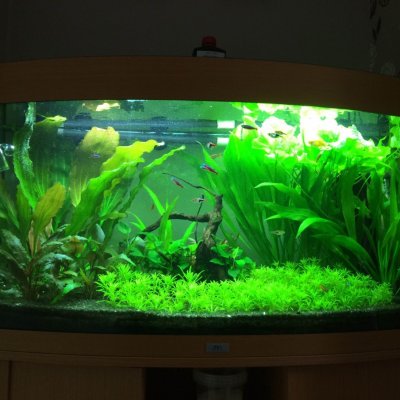Luananeko
Aquarium Advice Addict
I've been running my high light/mid tech (dose ferts and use liquid carbon instead of CO2 injection) 75g planted community tank for the last 5+ years. I like the tank, but the 50% weekly water changes and plant trimmings are getting a bit too time/energy consuming now that I'm pregnant with our first child... Considering how my free time is only going to be more scarce once the baby comes, I think it's time to scale back a bit. In the past I enjoyed having a fairly well stocked tank with lots of variety and color, but lately I've found I enjoy the fewer, larger, more personable fish like my Angelfish and my (recently passed) Red Tail Shark. Ideally, I'd like to drop down to a tank plan that only needs a large water change every 2-4 weeks instead.
My current substrate is a pretty deep sand/eco-complete/gravel mixture and has lots of light hungry stem plants, a red tiger lotus, and two amazon swords. I'd like to swap to straight sand of a minimal depth with driftwood bound plants/rocks, maybe other low tech plants and/or floaters (though they seem to struggle a little with my HOB filter) but am not as familiar with the best options. I do enjoy the tiger lotus and swords, but I'm guessing they need too much light/maintenance to fit in with the new plan, even if I let the tiger lotus float leaves on the surface. I've got a dual T5HO fixture currently, as well as a standard T8 strip light. I'm guessing I'd retire the T5HO and stick to the T8 with a plant bulb.
Based on how much of a tear down the above would take, I think it's easier to take the opportunity to rehome most of my existing stock and swap to something that would be more enjoyable. I love bichirs and have always wanted to keep one, and I love my current Angel, so those two are what I'm working the new stocking list around. I was leaning toward something along the lines of:
1 Polypterus palmas palmas
1 Angelfish (from current stock)
12 Congo Tetras
1 Gourami (likely Opaline or Pearl?)
What do you guys think? Workable plan and/or are there other interesting swaps you'd recommend instead of the Tetras and Gourami? Tips on light/plant combos that meet the low maintenance goal are appreciated too Thanks!
Thanks!
My current substrate is a pretty deep sand/eco-complete/gravel mixture and has lots of light hungry stem plants, a red tiger lotus, and two amazon swords. I'd like to swap to straight sand of a minimal depth with driftwood bound plants/rocks, maybe other low tech plants and/or floaters (though they seem to struggle a little with my HOB filter) but am not as familiar with the best options. I do enjoy the tiger lotus and swords, but I'm guessing they need too much light/maintenance to fit in with the new plan, even if I let the tiger lotus float leaves on the surface. I've got a dual T5HO fixture currently, as well as a standard T8 strip light. I'm guessing I'd retire the T5HO and stick to the T8 with a plant bulb.
Based on how much of a tear down the above would take, I think it's easier to take the opportunity to rehome most of my existing stock and swap to something that would be more enjoyable. I love bichirs and have always wanted to keep one, and I love my current Angel, so those two are what I'm working the new stocking list around. I was leaning toward something along the lines of:
1 Polypterus palmas palmas
1 Angelfish (from current stock)
12 Congo Tetras
1 Gourami (likely Opaline or Pearl?)
What do you guys think? Workable plan and/or are there other interesting swaps you'd recommend instead of the Tetras and Gourami? Tips on light/plant combos that meet the low maintenance goal are appreciated too

